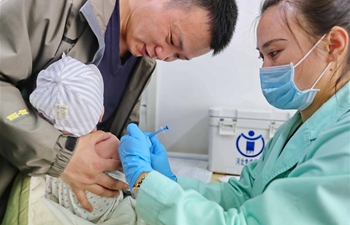CHICAGO, April 26 (Xinhua) -- A wristwatch-like motion-tracking device can detect movement problems in children whose impairments may be overlooked by doctors and parents, according to a study of Washington University School of Medicine in St. Louis.
The researchers used motion-tracking devices known as accelerometers to measure how much children use each arm in their daily lives. They recruited 185 kids between 2 months old and age 17 to wear a tracker on each wrist for four days, including while sleeping, bathing or playing sports. Of the participants, 29 had been diagnosed with motor impairments, and 156 had no motor or other neurological problems.
The researchers wrote an algorithm to analyze the data from the motion trackers, taking into account how often and how forcefully the children moved each arm, and how many of the movements involved both arms or just one.
They found that typically developing children under age 3 used both arms equally. After age 3, the ratio shifted in typically developing children, but only slightly; right-handed children used their left arms about 95 percent as much as they used their right arms, and vice versa for left-handed children. In children with motor impairments, the ratio was significantly more lopsided.
"Many of the children with impairments used one arm only 60 to 80 percent as much as the other, which is really abnormal," said senior author Nico Dosenbach, an assistant professor of neurology, occupational therapy and pediatrics. "Even that level of impairment is not always easy for a pediatrician to detect, because children often behave totally differently in the doctor's office than they do normally."
Clinicians sometimes rely on brain scans to identify brain damage and determine whether a child needs intensive therapy. But the size of the injury does not always reflect the true level of disability.
"You can have a small brain injury that results in a large deficit or a large brain injury that results in a minor deficit," said occupational therapist and graduate student Catherine Hoyt, the paper's first author. "By monitoring how children are actually using their arms, instead of measuring the size of the injury, we potentially could target resources to the children who could benefit the most."
The goal is to one day incorporate motion tracking into routine childhood checkups to identify children with motor impairments while their brains are still adaptable enough to respond well to therapy.
The motion trackers used in this study are reusable and cost under 250 dollars each, making them affordable enough for routine screening.
As many as 1 in 1,600 babies suffers a stroke during or around the time of birth.
The findings were published Friday in JAMA Network Open.
















